The Paleoproterozoic Evolution of Basement Rocks of the Taebaeksan Basin, Korean Peninsula, and Their Correlation to Those of the Paleoproterozoic Massifs in the Korean Peninsula
Abstract
1. Introduction
2. Regional Geology and Petrography
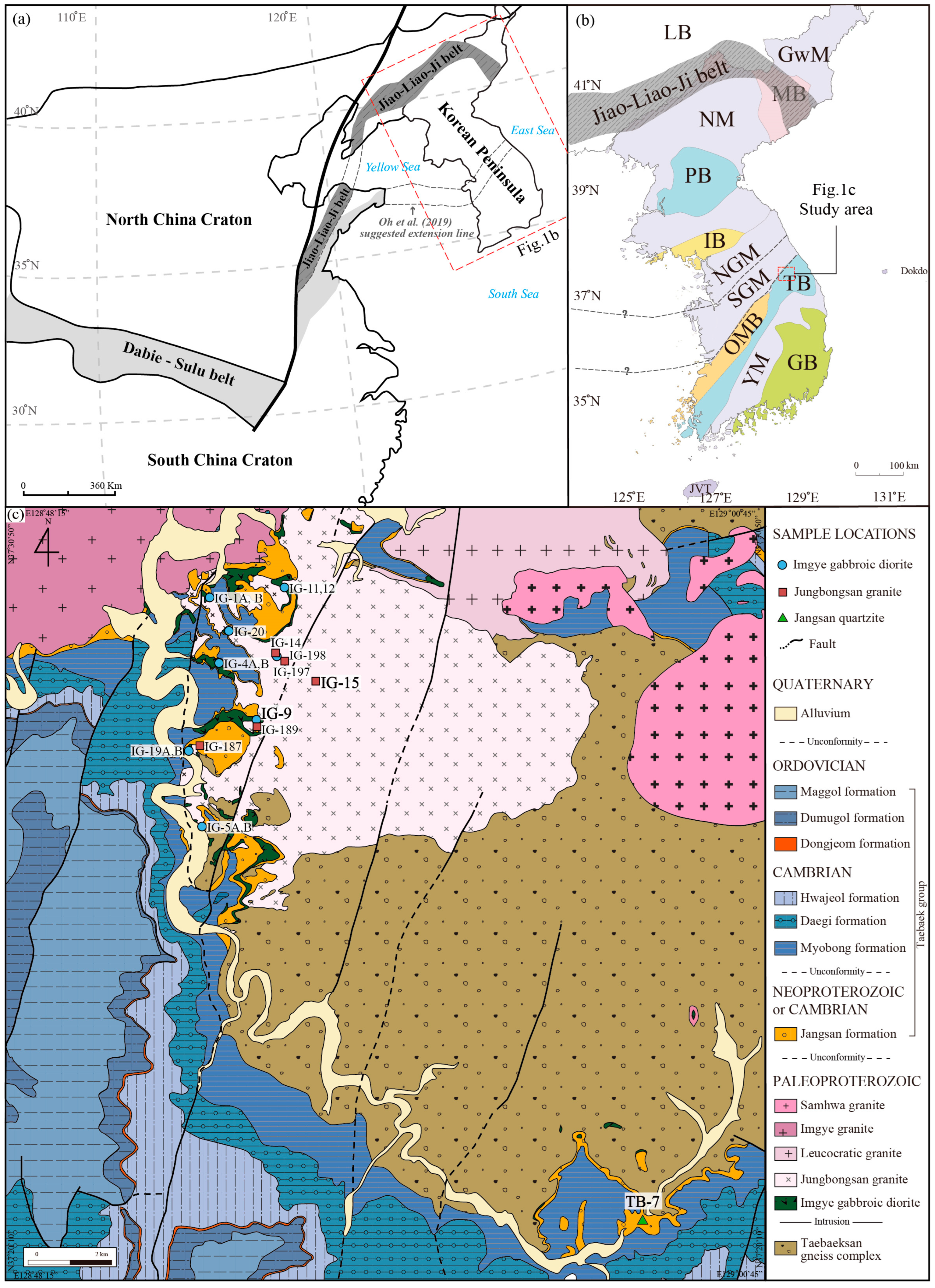
3. Analytical Methods
3.1. Whole-Rock Geochemistry
3.2. Mineral Chemistry
3.3. Zircon U–Pb Isotope Analysis
3.4. Zircon Lu–Hf Isotope Analysis
4. Results
4.1. Whole-Rock Geochemistry
4.2. Mineral Chemistry
4.3. Zircon U–Pb Isotope Analysis
4.3.1. Imgye Gabbroic Diorite
4.3.2. Jungbongsan Granite
4.3.3. Jangsan Quartzite
4.4. Zircon Lu–Hf Isotope Analysis
5. Discussion
5.1. Paleoproterozoic Igneous Event in the Imgye Area
5.2. Comparison between Paleoproterozoic Igneous Activities in the Study Area with Those in Other Paleoproterozoic Basements in the Korean Peninsula and China Craton
5.3. Paleoproterozoic Tectonic Evolution of the Northern Yeongnam Massif and the Imgye Area
6. Conclusions
- In the Imgye area, the Imgye gabbroic diorite intruded ca. 1948 Ma and the Jungbongsan granite intruded ca. 1873 Ma in an arc tectonic setting.
- The zircons in the Imgye gabbroic diorite have positive εHf(t) values from 3.5 to 9.7, whereas the zircons in the Jungbongsan granite show mostly negative εHf(t) values from −2.9 to 0.6. These data indicate that the Imgye gabbroic diorite was derived from a depleted mantle, and the Jungbongsan granite was derived from pre-existing Archean crust in an arc tectonic environment.
- The Jangsan quartzite in the Imgye area has the youngest detrital zircon of ca. 1856 Ma, with a peak concentration of ca. 2.5 Ga. These characteristics correlate well with the quartzite in the northeastern Yeongnam massif.
- The tectonic evolution of the Paleoproterozoic igneous rocks in the Imgye area differs from those of the Gyeonggi and Nangnim massifs but can be correlated well with that of the northern Yeongnam massif. Therefore, the Taebaeksan basin can be correlated to the northern Yeongnam massif.
Supplementary Materials
Author Contributions
Funding
Data Availability Statement
Acknowledgments
Conflicts of Interest
References
- Lee, D.S. (Ed.) Geology of Korea; Geological Society of Korea: Seoul, Republic of Korea, 1987; p. 514. [Google Scholar]
- Yin, A.; Nie, S. An indentationmodel for the north and South China collision and the development of the Tan-Lu and Honam fault systems, eastern Asia. Tectonics 1993, 12, 801–813. [Google Scholar] [CrossRef]
- Zhang, K.J. North and South China collision along the eastern and southern North China margins. Tectonophysics 1997, 270, 145–156. [Google Scholar] [CrossRef]
- Ishiwatari, A.; Tsujimori, T. Paleozoic ophiolites and blueschists in Japan and Russian Primorye in the tec-tonic framework of East Asia: A synthesis. Isl. Arc 2003, 12, 190–206. [Google Scholar] [CrossRef]
- Oh, C.W. A new concept on tectonic correlation between Korea, China and Japan: Histories from the late Proterozoic to cretaceous. Gondwana Res. 2006, 9, 47–61. [Google Scholar] [CrossRef]
- Oh, C.W.; Kusky, T. The Late Permian to Triassic Hongseong-Odesan Collision Belt in South Korea, and Its Tectonic Correlation with China and Japan. Int. Geol. Rev. 2007, 49, 636–657. [Google Scholar] [CrossRef]
- Zhao, G.; Cao, L.; Wilde, S.; Sun, M.; Choe, W.; Li, S. Implications based on the first SHRIMP U-Pb zircon dating on Precambrian granitoid rocks in North Korea. Earth Planet. Sci. Lett. 2006, 251, 365–379. [Google Scholar] [CrossRef]
- Yengkhom, K.S.; Lee, B.C.; Oh, C.W.; Yi, K. Tectonic and deformation history of the Gyeonggi Massif in and around the Hongcheon area, and its implications in the tectonic evolution of the North China Craton. Precambrian Res. 2014, 240, 37–59. [Google Scholar] [CrossRef]
- Zhao, L.; Zhang, Y.B.; Wu, F.Y.; Li, Q.L.; Yang, J.H.; Kim, J.N.; Choi, W.J. Paleoproterozoic high temperature metamorphism and anatexis in the northeastern Korean Peninsula: Constraints from petrology and zircon U-Pb geochemistry. Acta Petrol. Sin. 2016, 32, 3045–3069. [Google Scholar]
- Lee, B.C.; Cho, D.L. Zircon U-Pb and Rare Earth Elements Analyses on Banded Gneiss in Euiam Gneiss Complex, Central Gyeonggi Massif: Consideration for the Timing of Depositional Event and Metamorphism of the Basement Rocks in the Gyeonggi Massif. Korean J. Mineral. Petrol. 2022, 35, 215–233. [Google Scholar]
- Lee, B.C.; Oh, C.W.; Yengkhom, K.S.; Yi, K. Paleoproterozoic magmatic and metamorphic events in the Hongcheon area, southern margin of the Northern Gyeonggi Massif in the Korean Peninsula, and their links to the Paleoproterozoic orogeny in the North China Craton. Precambrian Res. 2014, 248, 17–38. [Google Scholar] [CrossRef]
- Lee, B.C.; Oh, C.W.; Kim, T.S.; Yi, K. The metamorphic evolution from ultrahigh-temperature to amphibolite facies metamorphism in the Odaesan area after the collision between the North and South China Cratons in the Korean Peninsula. Lithos 2016, 256, 109–131. [Google Scholar] [CrossRef]
- Wang, X.H.; Oh, C.W.; Lee, B.C.; Liu, F.L. Paleoproterozoic postcollisional metamor-phic and igneous activities in the Jinan area of the Jiao-Liao-Ji Belt in the North China Craton and their tectonic implications. Precambrian Res. 2020, 346, 105793. [Google Scholar] [CrossRef]
- Wang, X.H.; Oh, C.W.; Wang, X.; Zhai, M.G.; Zhao, L. The ~1.87 Ga granulite facies metamorphism of the South Liaohe Group in the Jiao-Liao-Ji Belt and its tectonic implications. Lithos 2021, 392–393, 106081. [Google Scholar] [CrossRef]
- Kim, S.W.; Williams, I.S.; Kwon, S.H.; Oh, C.W. SHRIMP zircon geochronology, and geochemical characteristics of metaplutonic rocks from the southwestern Gyeonggi Block, Korea: Implications for Paleoproterozoic to Mesozoic tectonic links between the Korean Peninsula and eastern China. Precambrian Res. 2008, 162, 475–497. [Google Scholar] [CrossRef]
- Lee, B.C.; Oh, C.W.; Yi, K.W. Geochemistry, zircon U-Pb ages, and Hf isotopic compositions of Precambrian gneisses in the Wonju-Jechon area of the southern Gyeonggi Massif: Implications for the Precambrian tectonic evolution of Korea and northeast Asia. Precambrian Res. 2016, 283, 169–189. [Google Scholar] [CrossRef]
- Kim, J.S. The Tectonic Evolution of Early Paleoproterozoic to Jurassic in the Janghowon Area of the Southern Middle Gyeonggi Massif. Master’s Thesis, Jeonbuk National University, Jeonju-si, Republic of Korea, 2022. [Google Scholar]
- Kim, N.; Cheong, C.S.; Park, K.H.; Kim, J.; Song, Y.S. Crustal evolution of northeastern Yeongnam Massif, Korea, revealed by SHRIMP U–Pb zircon geochronology and geochemistry. Gondwana Res. 2012, 21, 865–875. [Google Scholar] [CrossRef]
- Lee, Y.; Cho, M.; Cheong, W.; Yi, K. A massif–type (1.86 Ga) anorthosite complex in the Yeongnam Massif, Korea: Late–orogenic emplacement associated with the mantle delamination in the North China Craton. Terra Nova 2014, 26, 408–416. [Google Scholar] [CrossRef]
- Lee, B.C.; Oh, C.W.; Cho, D.L.; Yi, K. Paleoproterozoic (2.0–1.97 Ga) subduction-related magmatism on the north–central margin of the Yeongnam Massif, Korean Peninsula, and its tectonic implications for reconstruction of the Columbia supercontinent. Gondwana Res. 2019, 72, 34–53. [Google Scholar] [CrossRef]
- Lee, B.C.; Oh, C.W.; Wang, X. Paleoproterozoic (ca. 1.87–1.69 Ga) arc-related tectonothermal events on northcentral Yeongnam Massif, South Korea and its tectonic implications: Insights from metamorphism, geochemistry and geochronology. Precambrian Res. 2020, 338, 105562. [Google Scholar] [CrossRef]
- Cho, D.L.; Lee, B.C.; Oh, C.W. Petrogenesis of paleoproterozoic (2.02–1.96 Ga) metagranitoids in the southwestern Yeongnam Massif, Korean Peninsula, and their significance for the tectonic history of northeast Asia: Insights from zircon U–Pb–Hf isotope and whole-rock geochemical compositions. Precambrian Res. 2020, 340, 105631. [Google Scholar]
- Lee, K.S.; Chang, H.W.; Park, K.H. Neoproterozoic bimodal volcanism in the central Ogcheon belt, Korea: Age and tectonic implication. Precambrian Res. 1998, 89, 47–57. [Google Scholar] [CrossRef]
- Kim, S.W.; Oh, C.W.; Ryu, I.-C.; Willians, I.S.; Sajeev, K.; Santosh, M.; Rajesh, V.J. Neoproterozoic Bimodal Volcanism in the Okcheon Belt, South Korea, and its comparison with the Nanhua Rift, South China: Implications for rifting in Rodinia. J. Geol. 2006, 114, 717–733. [Google Scholar] [CrossRef]
- Ju, S.H.; Kim, S.J. Dating Study of Yeongnam Massif by Rb-Sr Method (Ⅰ); Research Report; Korea Power Resource Institute: Daejeon, Republic of Korea, 1985; Volume 85–24, pp. 7–40. [Google Scholar]
- Cheong, C.H. Stratigraphy and paleontology of the Samcheog coalfield, Gangweon-do, Korea. J. Geol. Soc. Korea 1969, 5, 13–56. [Google Scholar]
- Cheong, C.H.; Lee, D.S.; Um, S.H.; Chang, K.H. Investigation of Geological Classification of Korea. Minist. Sci. Technol. 1973, R-73-51, 68, (In Korean with English Abstract). [Google Scholar]
- Yun, S. Petrography, chemical composition, and depositional environments of the Cambro-Ordovician sedimentary sequence in the Yeonhwa I Mine area, southeastern Taebaegsan region, Korea. J. Geol. Soc. Korea 1978, 14, 145–174. [Google Scholar]
- Woo, J.; Shinn, Y.J.; Kwon, Y.K.; Chough, S.K. The Jangsan and Myeonsan formations (Early Cambrian) of the Taebaek Group, mideast Korea: Depositional processes and environments. Geosci. J. 2006, 10, 35–57. [Google Scholar] [CrossRef]
- Kim, J.H.; Kee, W.S.; Seo, S.K. Geological Structures of the Yeoryang-Imgye area, northern part of Mt. Taebaeg Region, Korea. Geol. Soc. Korea 1996, 32, 1–15. [Google Scholar]
- Chang, H.W.; Lee, D.H.; Park, K.H. Magmatism and metamorphism of the Proterozoic in the northeastern part of Korea: Petrogenetic and geochemical characteristics of the Okbang amphibolites. Econ. Environ. Geol. 1993, 26, 489–498. [Google Scholar]
- Kim, J.H.; Kee, W.S. Geological structures of the Imgye area, Kangweondo, Korea. Econ. Environ. Geol. 1991, 24, 43–55. [Google Scholar]
- Lee, Y.I.; Choi, T.; Lim, H.S.; Orihashi, Y. Detrital zircon U-Pb ages of the Jangsan Formation in the northeastern Okcheon belt, Korea and its implications for material source, provenance, and tectonic setting. Sediment. Geol. 2012, 282, 256–267. [Google Scholar] [CrossRef]
- Lee, Y.I.; Choi, T.; Lim, H.S. Depositional age and petrological characteristics of the Jangsan Formation in the Taebaeksan Basin, Korea-revisited. J. Geol. Soc. Korea 2016, 52, 67–77. [Google Scholar] [CrossRef]
- Lee, Y.I.; Choi, T.; Lim, H.S.; Orihashi, Y. Detrital zircon geochronology and Nd isotope geochemistry of the basal succession of the Taebaeksan Basin, South Korea: Implications for the Gondwana linkage of the Sino-Korean (North China) block during the Neoproterozoic-early Cambrian. Palaeogeogr. Palaeoclimatol. Palaeoecol. 2016, 441, 770–786. [Google Scholar] [CrossRef]
- Cho, K.; Park, K.-H.; Song, Y.-S.; Choi, J.E. Comparison of U-Pb Age Distribution Characteristics of Detrital Zircons in the Age-unknown Geumsusan Formation and Jangsan Formation of the Joseon Supergroup. Econ. Environ. Geol. 2019, 52, 49–64. [Google Scholar]
- Chough, S.K.; Kwon, Y.K.; Lee, H.S.; Woo, J. The Jangsan Formation refined. Geosci. J. 2022, 26, 545–554. [Google Scholar] [CrossRef]
- Kee, W.S.; Kim, J.H. Tectonic Significances of the Soonchang Shear Zone, the Hwasun Coalfield, Korea. J. Geol. Soc. Korea 1991, 27, 642–655. [Google Scholar]
- Kim, J.H.; Koh, H.J. Structural analysis of the Danyang area. Danyang Coalfield, Korea. Econ. Environ. Geol. 1992, 25, 61–72. [Google Scholar]
- Kim, J.H.; Lee, J.Y.; Nam, K.H.; Choi, B.Y. Paleostress analysis within the thrust zone. Yeongchun. Danyang Coalfield, Korea. J. Min. Geol. 1992, 28, 184–195. [Google Scholar]
- Park, H.I.; Jang, H.W.; Jin, M.S. Forming age of mineral deposits in Mt. Taebaek. J. Min. Geol. 1988, 21, 56–67. [Google Scholar]
- Kim, B.K.; Cheong, C.H.; Paik, K.H.; Kim, J.H.; Kim, J.Y. Crustal Evolution of the Korean Peninsula—In the eastern part of the Mt. Taebaeg Area—Part 1: Stratigraphy, paleontology and the geologic structures in the eastern part of the Samcheong Coalfied. J. Geol. Soc. Korea 1986, 22, 21–39. [Google Scholar]
- Oh, C.W.; Lee, B.C.; Yi, S.-B.; Rye, H.I. Correlation of Paleoproterozoic igneous and metamorphic events of the Korean Peninsula and China; Its implication to the tectonics of Northeast Asia. Precambrian Res. 2019, 326, 344–362. [Google Scholar] [CrossRef]
- Kee, W.S.; Kim, S.W.; Hong, P.S.; Lee, B.C.; Cho, D.R.; Byun, U.H.; Ko, K.; Kwon, C.W.; Kim, H.C.; Jang, Y.; et al. 1:1,000,000 Geological Map of Korea; Korea Institute of Geoscience and Mineral Resources: Daejeon, Repblic of Korea, 2020. [Google Scholar]
- Geological Investigation Corps of Taebaegsan Region (GICTR). Geological Maps of Taebagsan Region; Geological Survey of Korea and Geological Society of Korea: Seoul, Republic of Korea, 1962. [Google Scholar]
- Actlabs: Geochemistry/Assay Overview. Available online: https://actlabs.com/geochemistry/lithogeochemistry-and-whole-rock-analysis/lithogeochemistry/ (accessed on 22 December 2014).
- Ludwig, K.R. ISOPLOT 3.00: A Geochronological Toolkit for Microsoft Excel; Berkeley Geochronology Center: Berkeley, CA, USA, 2003; p. 39. [Google Scholar]
- Williams, I.S. U-Th-Pb geochronology by ion microprobe. In Applications of Microanalytical Techniques to Understanding Mineralizing Processes; McKibben, M.A., Shanks, W.C.P., Ridley, W.I., Eds.; Reviews in Economic Geology; Society of Economic Geologists (SEG): Littleton, CO, USA, 1998; Volume 7, pp. 1–35. [Google Scholar]
- Ireland, T.R.; Williams, I.S. Considerations in zircon geochronology by SIMS. In Zircon; Hanchar, J.M., Hoskin, P.W.O., Eds.; Reviews in Mineralogy and Geochemistry; Mineralogical Society of America: Chantilly, VA, USA, 2003; Volume 53, pp. 215–241. [Google Scholar]
- Ludwig, K. A User’s Manual for Isoplot 3.6: A Geochronological Toolkit for Microsoft Excel; Berkeley Geochronology Center Special Publication; Berkeley Geochronology Center: Berkeley, CA, USA, 2008; Volume 4, p. 77. [Google Scholar]
- Ludwig, K. SQUID 2.50. A User’Manual; Berkley Geochronology Center Special Publication; Berkeley Geochronology Center: Berkeley, CA, USA, 2009; Volume 5, p. 110. [Google Scholar]
- Steiger, R.H.; Jäger, E. Subcommission on geochronology: Convention on the use of decay constants in geo- and cosmochronology. Earth Planet. Sci. Lett. 1977, 36, 359–362. [Google Scholar] [CrossRef]
- Griffin, W.L.; Pearson, N.J.; Belousova, E.A.; Saeed, A. Comment: Hf-isotope heterogeneity in zircon 91500. Chem. Geol. 2006, 233, 358–363. [Google Scholar] [CrossRef]
- Polat, A.; Hofmann, A.W. Alteration and geochemical patterns in the 3.7–3.8 Ga Isua greenstone belt, West Greenland. Precambrian Res. 2003, 126, 197–218. [Google Scholar] [CrossRef]
- Middlemost, E.A. Naming materials in the magma/igneous rock system. Earth-Sci. Rev. 1994, 37, 215–224. [Google Scholar] [CrossRef]
- Peccerillo, A.; Taylor, S.R. Geochemistry of Eocene calc-alkaline volcanic rocks from the Kastamonu area, Northern Turkey. Contrib. Mineral. Petrol. 1976, 58, 63–81. [Google Scholar] [CrossRef]
- Irvine, T.N.; Baragar, W.R.A. A guide to the chemical classification of the common volcanic rocks. Can. J. Earth Sci. 1971, 8, 523–548. [Google Scholar] [CrossRef]
- Streckeisen, A. To each plutonic rock its proper name. Earth-Sci. Rev. 1976, 12, 1–33. [Google Scholar] [CrossRef]
- So, C.-S.; Kim, Y.-K.; Chi, S.-J.; Park, M.-E. Origin of Massive amphibolitic rocks in Imgye area, Korea. Min. Geol. 1981, 14, 183–191. [Google Scholar]
- Chang, H.W.; Lee, D.H. Magmatism and Metamorphism of the Proterozoic in the Northeastern part of Korea: Tectonomagmatic characteristics of the Imgye hornblendites. J. Korea Inst. Min. Geol. 1993, 26, 499–505. [Google Scholar]
- Lee, Y.; Cho, M.; Roeske, S.M. Fluid-present partial melting of Paleoproterozoic Okbang amphibolite in the Yeongnam Massif, Korea. Lithosphere 2020, 2020, 8854615. [Google Scholar] [CrossRef]
- Kim, N.H.; Song, Y.S.; Park, K.H.; Lee, H.S. SHRIMP U-Pb Zircon Ages of the Granite Gneisses from the Pyeonghae Area of the northeastern Yeongnam Massif (Sobaeksan Massif). J. Petrol. Soc. Korea 2009, 18, 31–47. [Google Scholar]
- Kim, N.; Cheong, C.S.; Yi, K.; Song, Y.S.; Park, K.H.; Geng, J.Z.; Li, H.K. Zircon U-Pb geochronological and Hf isotopic constraints on the Precambrian crustal evolution of the north-eastern Yeongnam Massif, Korea. Precambrian Res. 2014, 242, 1–21. [Google Scholar] [CrossRef]
- Lee, S.G.; Asahara, Y.; Tanaka, T.; Kim, N.H.; Kim, K.H.; Yi, K.; Masuda, A.; Song, Y.S. La-Ce and Sm-Nd isotopic systematics fo early Paleoproterozoic leucogranite with tetrad Ree pattern. Chem. Geol. 2010, 276, 360–373. [Google Scholar] [CrossRef]
- Lee, S.G.; Shin, S.C.; Jin, M.S.; Ogasawara, M.; Yang, M.K. Two Paleoproterozoic strongly peraluminous granitic plutons (Nonggeori and Naedeokri granites) at the northeastern part of Yeongnam Massif, Korea: Geochemical and isotopic constraints in East Asian crustal formation history. Precambrian Res. 2005, 139, 101–120. [Google Scholar] [CrossRef]
- Cabanis, B.; Lecolle, M. Le diagramme La/10-Y-15-Nb/8: Unoutil pour la discrimination des series volcaniques et al mise enevidence des porcessus de mélange et/ou de contamination crustale. Comptes Rendus L’academie Des Sci. 1989, 309, 2023–2029. [Google Scholar]
- Pearce, J.A. Trace element characteristics of lavas from destructive plate boundaries. In Orogenic Andesites and Related Rocks; John Wiley and Sons: Hoboken, NJ, USA, 1982; pp. 528–548. [Google Scholar]
- Pearce, J.A.; Cann, J.R. Tectonic setting of basic volcanic setting of basic volcanic rocks determined using trace element analyses. Earth Planet. Sci. Lett. 1973, 19, 290–300. [Google Scholar] [CrossRef]
- Saccani, E. A new method of discriminating different types of post-Archean ophiolitic basalts and their tectonic significance using Th-Nb and Ce-Dy-Yb systematics. Geosci. Front. 2015, 6, 481–501. [Google Scholar] [CrossRef]
- Pearce, J.A.; Harris, N.B.; Tindle, A.G. Trace element discrimination diagrams for the tectonic interpretation of granitic rocks. J. Petrol. 1984, 25, 956–983. [Google Scholar] [CrossRef]
- McDonough, W.F.; Sun, S.S. The composition of the Earth1. Chem. Geol. 1995, 120, 223–253. [Google Scholar] [CrossRef]
- Leake, B.E.; Woolley, A.R.; Arps, C.E.S.; Birch, W.D.; Gilbert, M.C.; Grice, J.D.; Hawthorne, F.C.; Kato, A.; Kisch, H.J.; Krivovichev, V.G.; et al. Nomenclature of amphiboles: Report of the subcommittee on amphiboles of the International Mineralogical Association Commission on new mineral and mineral names. Mineral. Mag. 1997, 61, 295–321. [Google Scholar] [CrossRef]
- Smith, J.V.; Brown, W.L. Feldspar Minerals; Springer: Berlin, Germany, 1974; pp. 1–690. [Google Scholar]
- Fu, B.; Mernagh, T.P.; Kita, N.T.; Kemp, A.I.; Valley, J.W. Distinguishing magmatic zircon from hydrothermal zircon: A case study from the Gidginbung high-sulphidation Au–Ag–(Cu) deposit, SE Australia. Chem. Geol. 2009, 259, 131–142. [Google Scholar] [CrossRef]
- Farmer, G.L.; Holland, H.D.; Turekian, K.K. Continental basaltic rocks. Crust 2003, 3, 85–121. [Google Scholar]
- Pearce, J.A. Geochemical fingerprinting of oceanic basalts with applications to ophiolite classification and the search for Archean oceanic crust. Lithos 2008, 100, 14–48. [Google Scholar] [CrossRef]
- Aldanmaz, E.R.C.A.N.; Pearce, J.A.; Thirlwall, M.F.; Mitchell, J.G. Petrogenetic evolution of late Cenozoic, post-collision volcanism in western Anatolia, Turkey. J. Volcanol. Geother. Res. 2000, 102, 67–95. [Google Scholar] [CrossRef]
- Shaw, E.F. Agenda-Setting and Mass Communication Theory; Gazette: Leiden, The Netherlands, 1979; Volume 25, pp. 96–105. [Google Scholar]
- Gurenko, A.A.; Chaussidon, M. Enriched and depleted primitive melts included in olivine from Icelandic tholeiites: Origin by continuous melting of a single mantle column. Geochim. Cosmochim. Acta 1995, 59, 2905–2917. [Google Scholar] [CrossRef]
- Lee, B.C.; Park, J.H.; Oh, C.W.; Yi, K. Metamorphic and magmatic evolution of the Paleoproterozoic gneisses in the Sancheong area, Yeongnam Massif, South Korea, and their implications to the tectonic in the Northeast Asia. Precambrian Res. 2017, 298, 439–461. [Google Scholar] [CrossRef]
- Kim, Y.H. The Study on the Igneous and Metamorphic Activities from the Precambrian to the Triassic in Gapyeong Area, Located in the Central Part of the Gyeonggi Massif in the Korean Peninsula. Master’s Thesis, Jeonbuk National University, Jeonju-si, Republic of Korea, 2021. [Google Scholar]
- Kang, M.S. The Tectonic Evolution from the Archean to Triassic in the Hongcheon Area, the Central Part of the Northern Gyeonggi Massif in the Korean Peninsula. Master’s Thesis, Jeonbuk National University, Jeonju-si, Republic of Korea, 2022. [Google Scholar]
- Lee, Y.I.; Choi, T.; Lim, H.S. Reply to the comment on “Depositional age and petrological characteristics of the Jangsan Formation in the Taebaeksan Basin, Korea-revisited” by Lee, Y.I.; Choi, T.; Lim, H.S.; J. Geol. Soc. Korea, 2016, 52, 67–77. J. Geol. Soc. Korea 2016, 52, 969–973. [Google Scholar] [CrossRef]
- Hu, B.; Zhai, M.; Li, T.; Li, Z.; Peng, P.; Guo, J.; Kusky, T.M. Mesoproterozoic magmatic events in the eastern North China Craton and their tectonic implications: Geochronological evidence from detrital zircons in the Shandong Peninsula and North Korea. Gondwana Res. 2012, 22, 828–842. [Google Scholar] [CrossRef]
- Cho, D.-L.; Lee, S.H.; Park, J.-Y. Geological Report of the Baengyeongdo·Daecheongdo·Socheongdo sheets (1:50,000). Korea Inst. Geosci. Miner. Resour. 2021. (In Korean with English abstract). [Google Scholar]
- Jeong, J.W.; Oh, C.W.; Cho, D.-L. The Neoproterozoic to Triassic tectonic evolution of Jangbong Island in the northwestern Gyeonggi Massif on the Korean Peninsula. Lithos 2021, 390–391, 106102. [Google Scholar] [CrossRef]
- Kim, M.J.; Ha, Y.; Park, J.-W.; Park, K.-H. U-Pb ages and Hf isotopic compositions of the detrital Zircons from Baengnyeongdo and Daecheongdo: Correlation with North Korea and the North China Craton. J. Geol. Soc. Korea 2021, 57, 17–33, (In Korean with English abstract). [Google Scholar] [CrossRef]
- Peng, P.; Zhang, Z.Y.; Zhang, Y.B.; Guo, J.H.; Zhai, M.G. Review on geological evolution of the Pyongnam basin in Korean Peninsula. Acta Petrol. Sin. 2021, 37, 129–142, (In Chinese with English abstract). [Google Scholar] [CrossRef]
- Kim, S.W.; Kee, W.S.; Santosh, M.; Cho, D.-L.; Hong, P.S.; Ko, K.; Lee, B.C.; Byun, U.K.; Jang, Y. Tracing the Precambrian tectonic history of East Asia from Neoproterozoic sedimentation and magmatism in the Korean Peninsula. Earth-Sci. Rev. 2020, 209, 103311. [Google Scholar] [CrossRef]
- Choi, D.K. A new view on the early Paleozoic paleogeography and paleoenironments of the Taebaeksan Basin Korea. J. Paleontol. Soc. Korea 2011, 27, 1–11. [Google Scholar]
- McKenzie, N.R.; Hughes, N.C.; Myrow, P.M.; Choi, D.K.; Park, T.Y. Trilobites and zircons link north China with the eastern Himalaya during the Cambrian. Geology 2011, 39, 591–594. [Google Scholar] [CrossRef]
- Cheong, W.S.; Na, K.C. Origin and Evolution of Leucogranite of NE Yeongnam Massif from Samcheok Area, Korea. J. Petrol. Soc. Korea 2008, 17, 16–35. [Google Scholar]
- Kim, J.; Cho, M. Low-pressure metamorphism and leucogranite magmatism, northeastern Yeongnam Massif, Korea: Implication for Paleoproterozoic crustal evolution. Precambrian Res. 2003, 122, 235–251. [Google Scholar] [CrossRef]
- Lee, S.H.; Oh, C.W.; Park, J.W. The age and geochemistry of the mid-Cretaceous volcanic rocks in the Jinan Basin: Implications for the mid-Cretaceous tectonic environments of the Korean Peninsula and Northeast Asia. Lithos 2020, 358, 105383. [Google Scholar] [CrossRef]
- Lee, S.H.; Oh, C.W.; Jung, S. Jurassic Igneous Activity in the Yuseong Area on the Southern Margin of the Gyeonggi Massif, Korean Peninsula, and Its Implications for the Tectonic Evolution of Northeast Asia during the Jurassic. Minerals 2021, 11, 466. [Google Scholar] [CrossRef]
- Lee, S.H.; Oh, C.W.; Kawaguchi, K. Cretaceous igneous activity and tectonic evolution of the northeast Asia including the Korean Peninsula. J. Geol. Soc. Korea 2021, 57, 589–614. [Google Scholar] [CrossRef]
- Zhai, M.; Zhang, Y.; Zhang, X.; Wu, F.; Peng, P.; Li, Q.; Hou, Q.; Li, T.; Zhao, L. Renewed profile of the Mesozoic mag-matism in Korean Peninsula: Regional correlation and broader implication for cratonic destruction in the North China Craton. Sci. China Earth Sci. 2016, 59, 2355–2388. [Google Scholar] [CrossRef]
- Oh, C.W.; Kim, S.W.; Williams, I.S. Spinel granulite in Odesan area, South China blocks. Lithos 2006, 92, 557–575. [Google Scholar] [CrossRef]
- Yi, K.; Cho, M. SHRIMP geochronology and reaction texture of monazite from a retrogressive transitional layer, Hwacheon Granulite Complex, Korea. Geosci. J. 2009, 13, 293–304. [Google Scholar] [CrossRef]
- Lee, S.R.; Cho, M.; Yi, K.; Stern, R.A. Early Proterozoic granulites in central Korea: Tectonic correlation with Chinese cratons. J. Geol. 2000, 108, 729–738. [Google Scholar] [CrossRef]
- Oh, C.W.; Lee, J.Y.; Yengkhom, K.S.; Lee, B.C.; Ryu, H.I. Neoproterozoic igneous activity and Permo-Triassic metamorphism inthe Gapyeong area within the Gyeonggi Massif, South Korea, and theirimplication for the tectonics of northeastern Asia. Lithos 2018, 322, 1–19. [Google Scholar] [CrossRef]
- Kee, W.; Kim, H.; Kim, B.C.; Choi, S.; Park, S.; Hwang, S.K. Geological Report of the Seoraksan Sheet scale 1:50,000; Korea Institute of Geoscience and Mineral Resources: Daejeon, Republic of Korea, 2010. [Google Scholar]
- Cho, M.; Kim, T.; Yang, S.; Yi, K. Paleoproterozoic to Triassic crustal evolution of the Gyeonggi Massif, Korea: Tectonic correlation with the North China craton. Mem. Geol. Soc. Am. 2017, 213, 165–197. [Google Scholar]
- Kee, W.; Koh, H.; Kim, S.W.; Kim, Y.B.; Kihm, Y.H.; Kim, H.; Park, S.; Song, K.; Lee, S.R.; Lee, Y.; et al. Tectonic Evolution of the Upper Crustal Units in the Mid-Western Part of the Korean Peninsula; Korea Institute of Geoscience and Mineral Resources: Daejeon, Republic of Korea, 2011. [Google Scholar]
- Song, K.; Cho, D. Geological Report of the Mandaeri Sheet Scale 1:50,000; Korea Institute of Geoscience and Mineral Resources: Daejeon, Republic of Korea, 2009. [Google Scholar]
- Choi, P.; Kim, H.; Lee, S.R.; Gwon, S. Geological Report of the Inje Sheet Scale 1:50,000; Korea Institute of Geoscience and Mineral Resources: Daejeon, Republic of Korea, 2009. [Google Scholar]
- Kee, W.; Cho, D.; Kim, B.C.; Jin, K. Geological Report of the Pocheon Sheet Scale 1:50,000; Korea Institute of Geoscience and Mineral Resources: Daejeon, Republic of Korea, 2005. [Google Scholar]
- Oh, C.W.; Imayama, T.; Lee, S.Y.; Yi, S.B.; Yi, K.; Lee, B.C. Permo-Triassic and Paleoproterozoic metamorphism related to continental collision in Yangpyeong, South Korea. Lithos 2015, 216, 264–284. [Google Scholar] [CrossRef]
- Kim, J.S. The Paleoproterozoic Igneous and Metamorphic Activities in the Janghowon Area, the Southern Middle Gyeonggi Massif and Their Meaning to the Tectonic Evolution of the Northeast Asia. Master’s Thesis, Jeonbuk National University, Jeonju, Republic of Korea, 2022. [Google Scholar]
- Song, Y.-S.; Park, K.-H.; Seo, J.; Jo, H.J.; Yi, K. SHRIMP zircon Ages of the Basement Gneiss Complex in the Pyeongchang-Wonju Area, Gyeonggi Massif, Korea. J. Geol. Soc. Korea 2011, 20, 99–114. (In Korean) [Google Scholar]
- Santosh, M.; Hu, C.N.; Kim, S.W.; Tang, L.; Kee, W.S. Late Paleoproterozoic ultrahigh-temperature metamorphism in the Korean Peninsula. Precambrian Res. 2018, 308, 111–125. [Google Scholar] [CrossRef]
- Koh, H.J.; Kim, S.W.; Lee, S.R. Geological Report of the Anheungri Sheet Scale 1:50,000; Korea Institute of Geoscience and Mineral Resources: Daejeon, Republic of Korea, 2011. [Google Scholar]
- Kim, S.W.; Koh, H.J.; Kim, J.M. Geochronological study for the gneiss complex in the Wonju-Anheung-Pyeongchang area, central part of the Korean Peninsula. J. Geol. Soc. Korea 2014, 50, 327–342. [Google Scholar] [CrossRef]
- Kim, N.H. Petrology, Geochemistry and Geochronology Study of Precambrian Basement Rocks in the Northeastern Yeongnam Massif, South Korea: Their Tectonic Implications. Doctoral Dissertation, Pukyong National University, Busan, Republic of Korea, 2010. [Google Scholar]
- Lee, H.S.; Park, K.-H.; Song, Y.S.; Kim, N.H.; Orihashi, Y. LA-ICP-MS U-Pb Zircon Age of the Hongjesa Granite in the Northeast Yeongnam Massif. J. Petrol. Sci. Korea 2010, 19, 103–108. [Google Scholar]
- Kim, J.; Lee, Y. A Study on the Geochronology of the Precambrian Basement Rocks in the Korean Peninsula; Korea Institute of Geoscience and Mineral Resources: Daejeon, Republic of Korea, 2017. [Google Scholar]
- Ryoo, C.; Kang, H.; Lee, S. Ductile Shear Deformation around Jirisan Area, Korea. J. Petrol. Soc. Korea 2019, 28, 53–69. [Google Scholar]
- Oh, C.W.; Lee, B.C.; Lee, S.; Kim, M.; Lee, B.; Choi, S. The tectonic evolution and important geoheritages in the Jinan and Muju area, Jeollabuk-do. J. Geol. Soc. Korea 2016, 52, 709–738. [Google Scholar] [CrossRef]
- Lee, Y.; Cho, M.; Kim, T.; Kim, H. Incipient charnockite formation at the waning stage of Paleoproterozoic hot orogenesis, Yeongnam Massif, Korea. Precambrian Res. 2021, 365, 106388. [Google Scholar] [CrossRef]
- Kim, S.W.; Kwon, S.; Yi, K.; Santosh, M. Arc magmatism in the Yeongnam massif, Korean Peninsula: Imprints of Columbia and Rodinia supercontinents. Gondwana Res. 2014, 26, 1009–1027. [Google Scholar] [CrossRef]
- Lee, Y.Y.; Cho, M.; Yi, K. In situ U–Pb and Lu–Hf isotopic studies of zircons from the Sancheong–Hadong AMCG suite, Yeongnam Massif, Korea: Implications for the petrogenesis of 1.86 Ga massif-type anorthosite. J. Asian Earth Sci. 2017, 138, 629–646. [Google Scholar] [CrossRef]
- Lee, Y.Y.; Cho, M.; Cheong, W.; Yi, K. Prolonged high–temperature, low–pressure metamorphism associated with 1.86 Ga Sancheong–Hadong anorthosite in the Yeongnam Massif, Korea: Paleoproterozoic hot orogenesis in the North China Craton. Precambrian Res. 2018, 307, 175–200. [Google Scholar] [CrossRef]
- Kim, S.W.; Park, S.; Kee, W.; Kim, B.C. Geological Report of the Goheung Sheet Scale 1:50,000; Korea Institute of Geoscience and Mineral Resources: Daejeon, Republic of Korea, 2015. [Google Scholar]
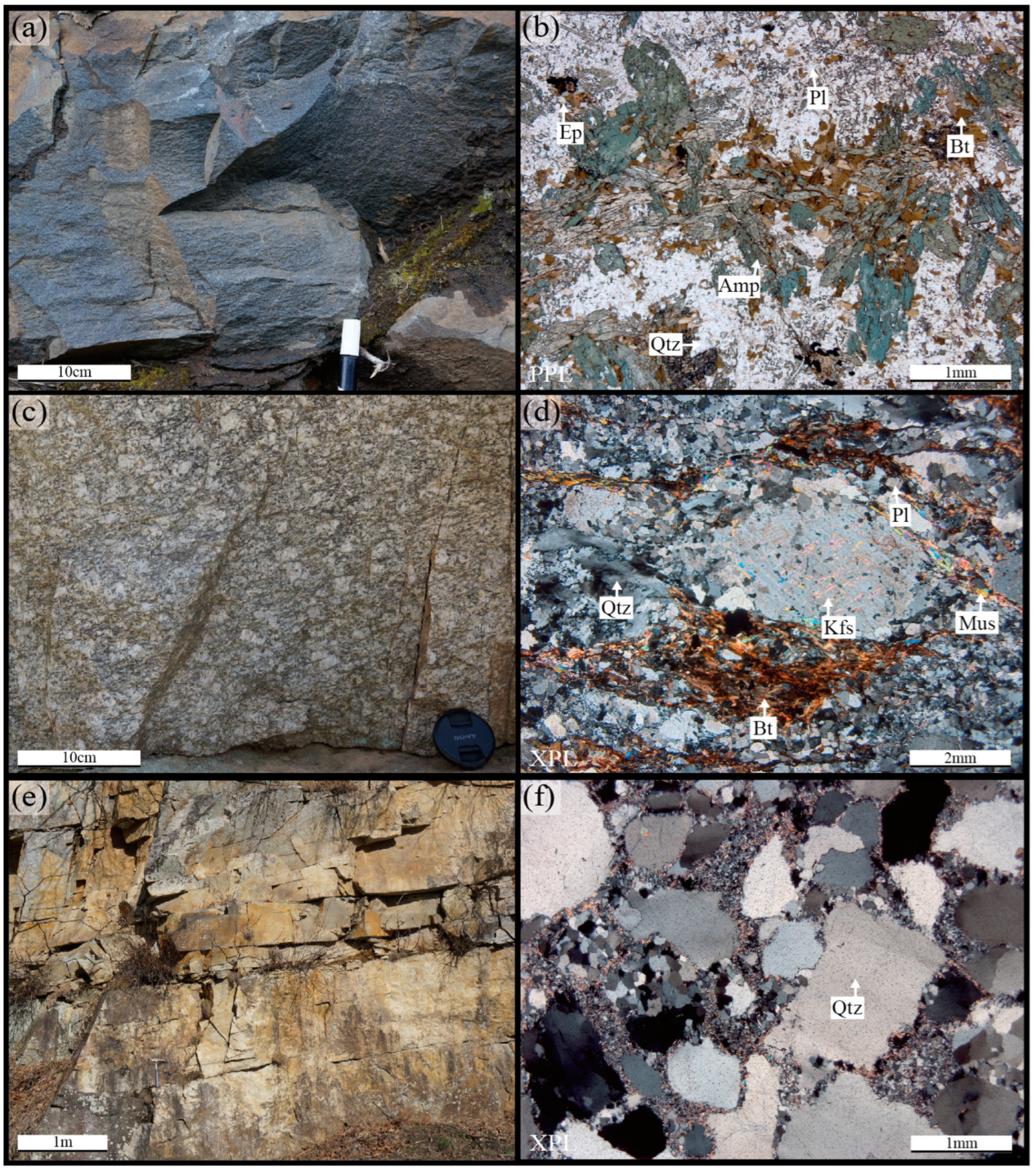
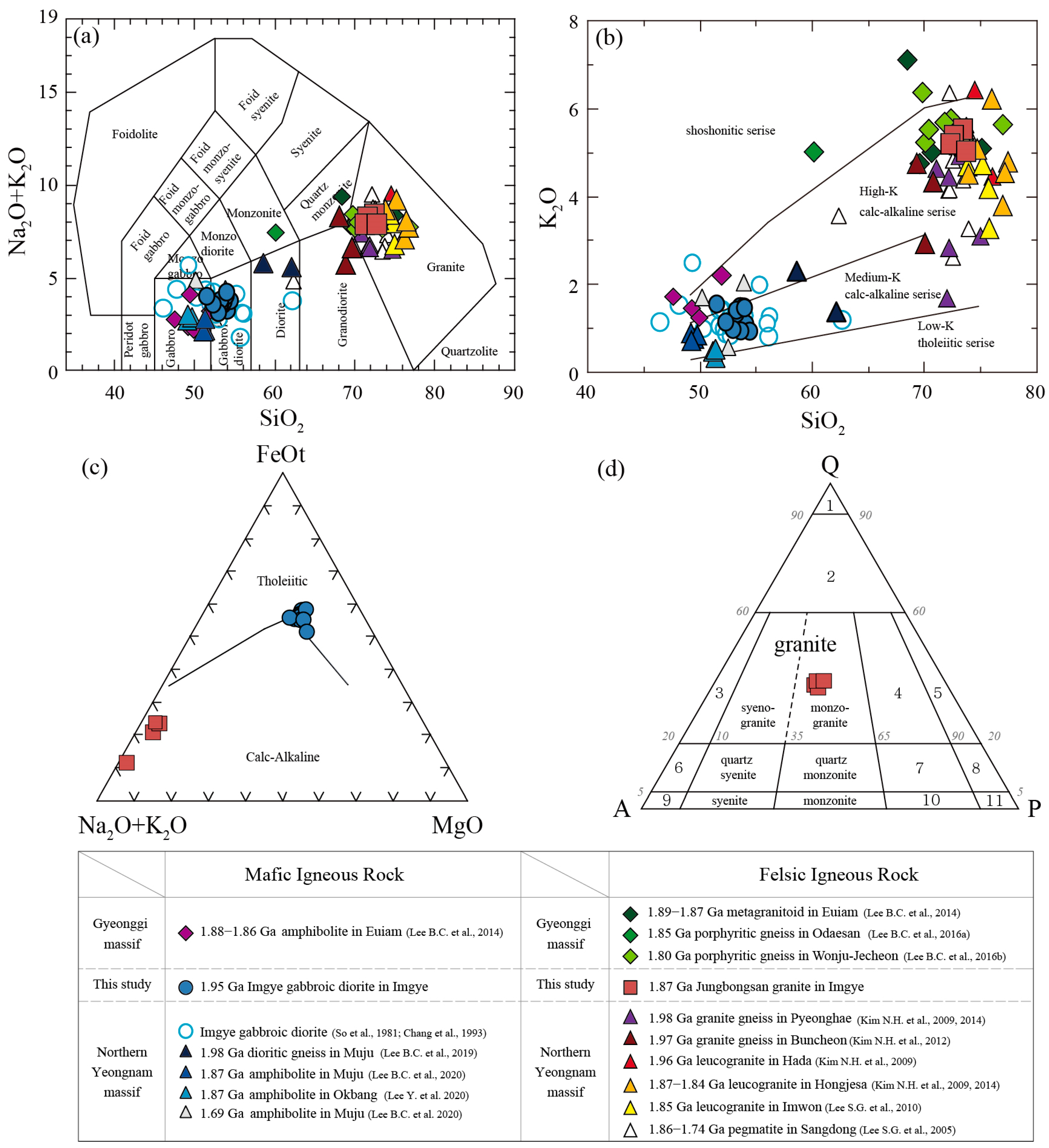
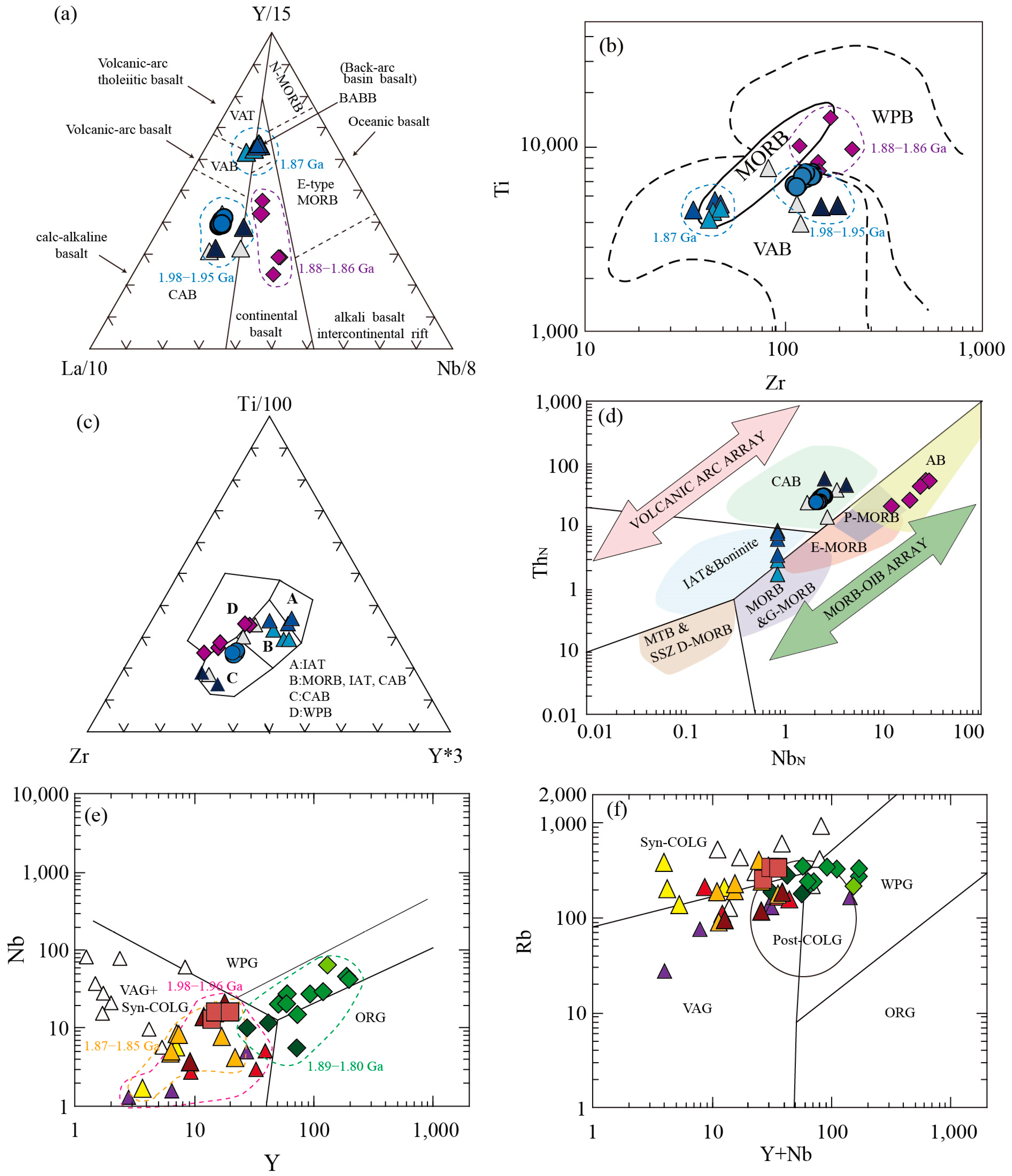

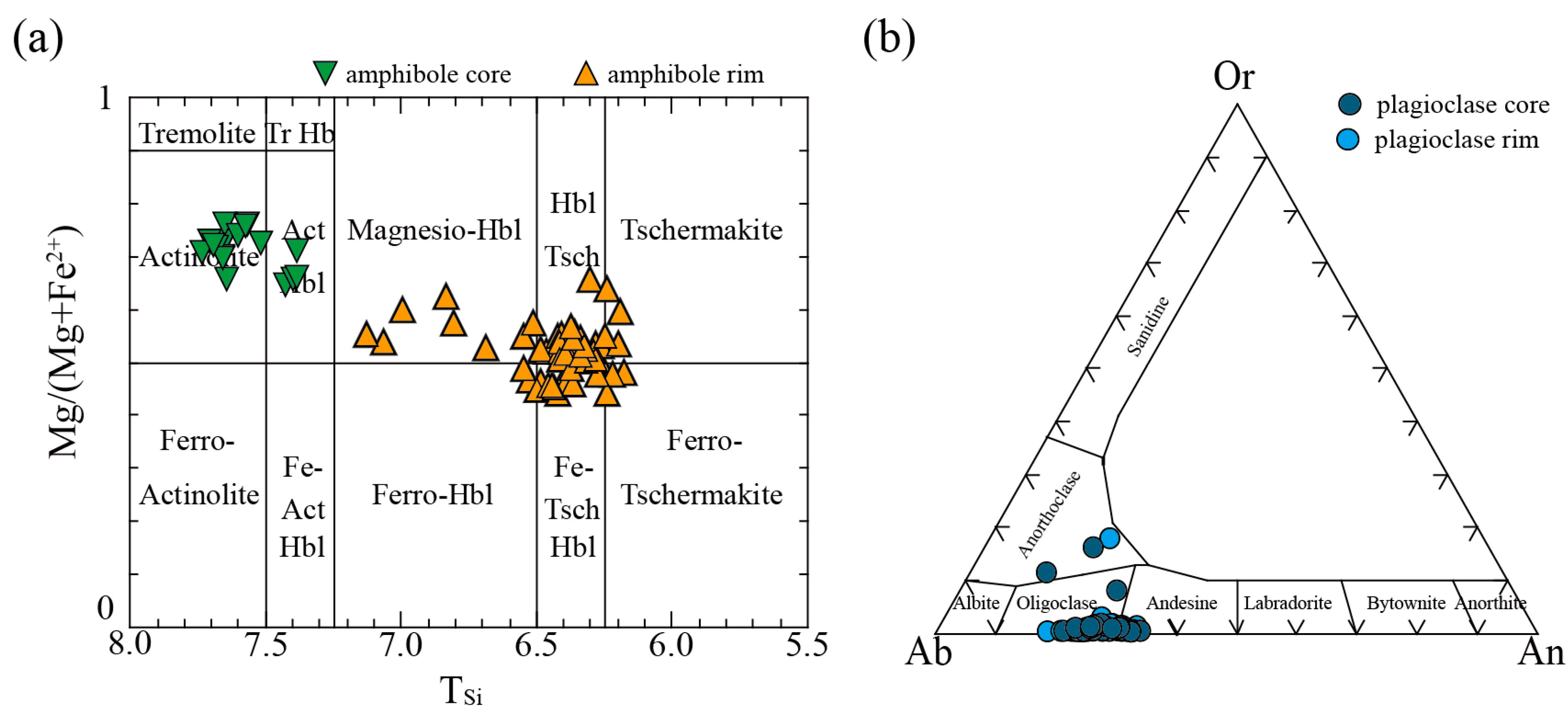

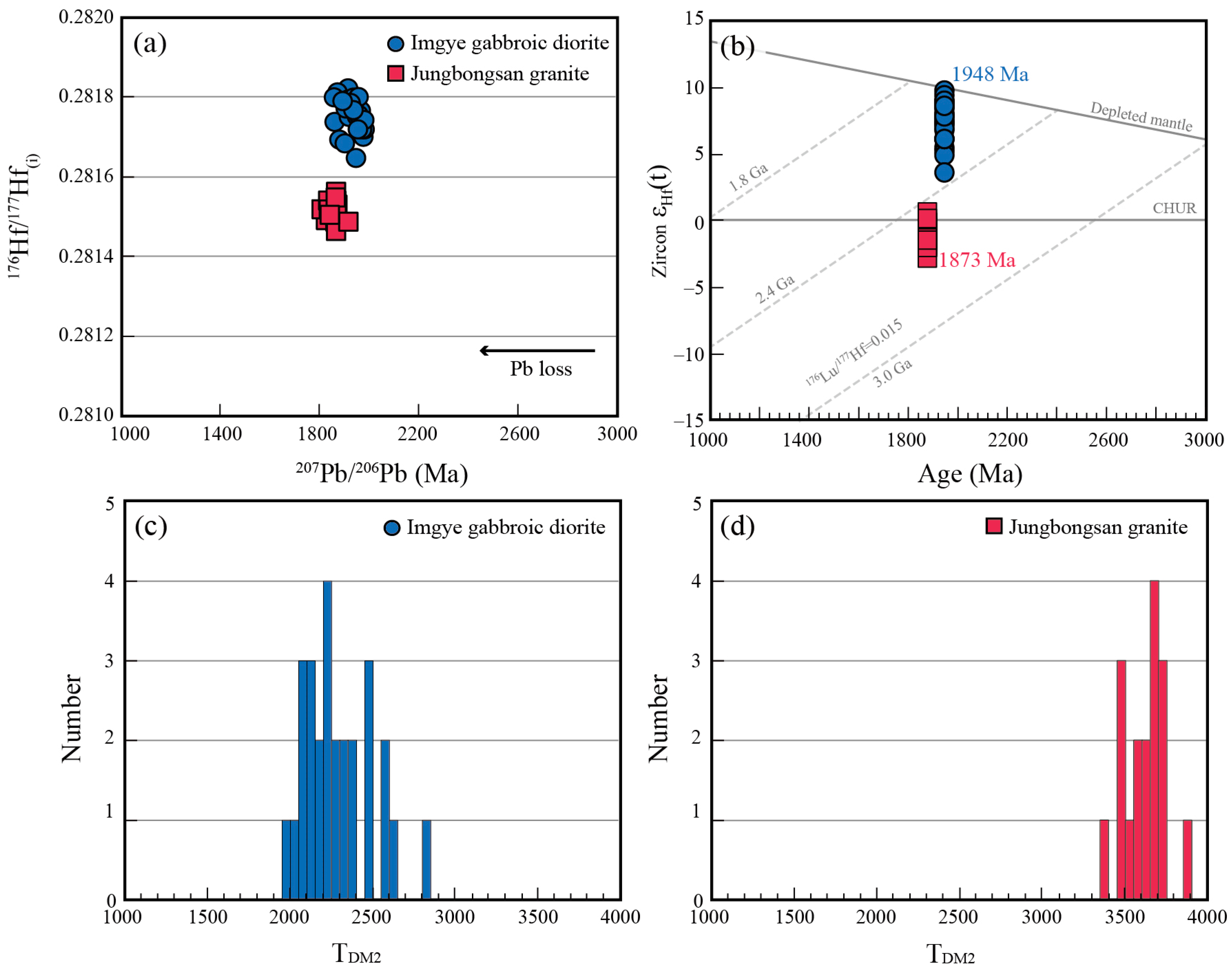


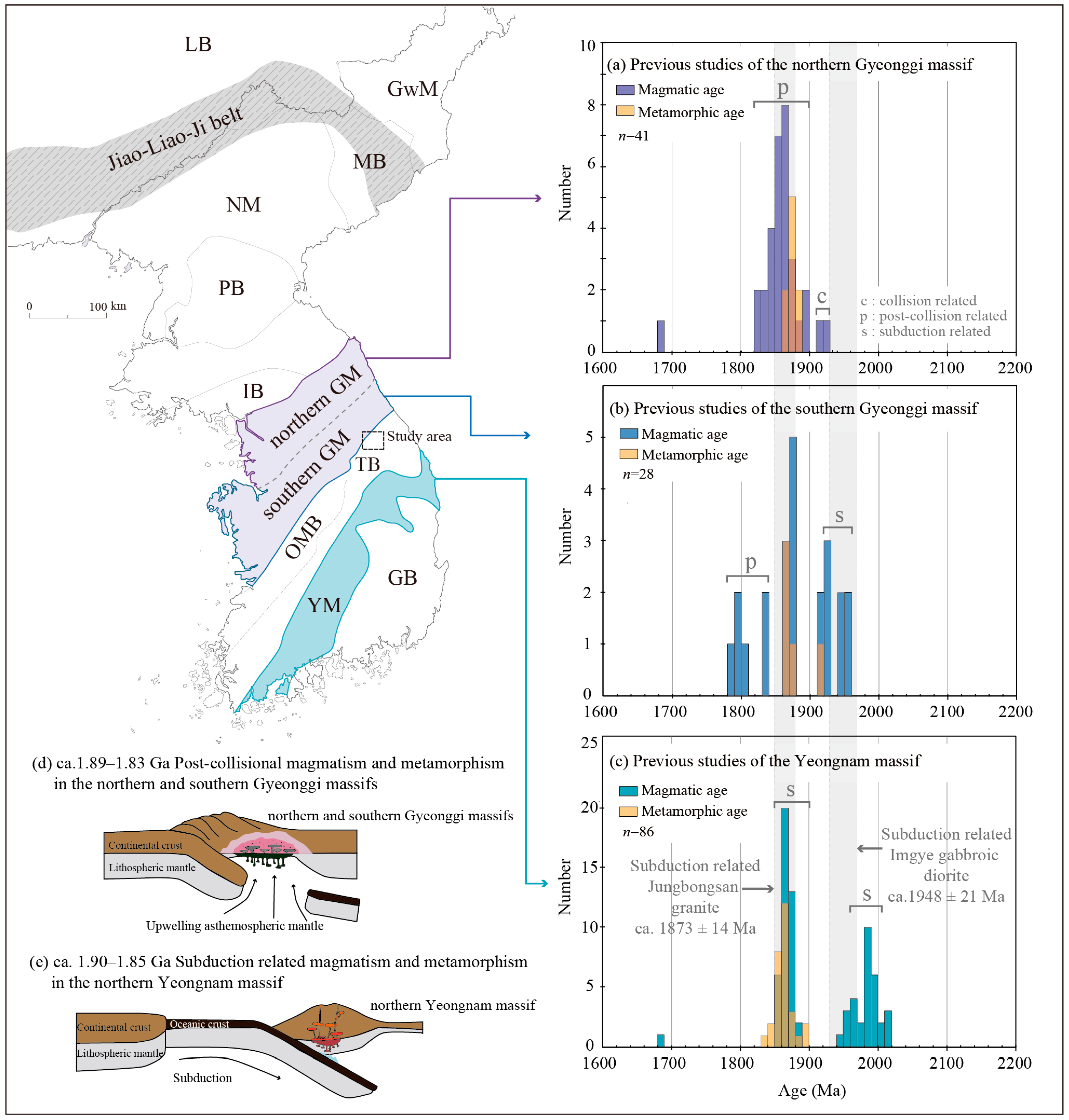
| Time (Ga) | Event | Location | |||||
|---|---|---|---|---|---|---|---|
| Taebaeksan Basin (Imgye) | Northern Yeongnam Massif | Southern Gyeonggi Massif | Northern Gyeonggi Massif | Nangnim Massif | Jiao–Liao–Ji Belt in North China Craton | ||
| 2.2–2.1 | Magmatism | - | - | - | - | - | Arc-related |
| Metamorphism | - | - | - | - | - | - | |
| 2.1–2.0 | Magmatism | - | - | - | Arc-related | Granite emplacement | - |
| Metamorphism | - | - | - | - | - | - | |
| 1.99–1.96 | Magmatism | - | Arc-related | - | - | - | - |
| Metamorphism | - | - | - | - | - | - | |
| 1.95–1.90 | Magmatism | Arc-related | - | Arc-related | Collision -related | S-type granite emplacement | - |
| Metamorphism | - | - | Migmatization | Intermediate-P/T | Intermediate-P/T | Intermediate-P/T | |
| 1.89–1.85 | Magmatism | Arc-related | Arc-related | - | Post-collision -related | Post-collision -related | Post-collision -related |
| Metamorphism | - | Low-P/T | - | Low-P/T | Low-P/T | Low-P/T | |
| 1.84–1.80 | Magmatism | - | - | Post-collision -related | Within Plate rifting-related | Post-collision -related | Post-collision -related |
| Metamorphism | - | - | Low-P/T | - | Migmatization | Low-P/T | |
Disclaimer/Publisher’s Note: The statements, opinions and data contained in all publications are solely those of the individual author(s) and contributor(s) and not of MDPI and/or the editor(s). MDPI and/or the editor(s) disclaim responsibility for any injury to people or property resulting from any ideas, methods, instructions or products referred to in the content. |
© 2023 by the authors. Licensee MDPI, Basel, Switzerland. This article is an open access article distributed under the terms and conditions of the Creative Commons Attribution (CC BY) license (https://creativecommons.org/licenses/by/4.0/).
Share and Cite
Lee, B.Y.; Cho, D.-L.; Oh, C.W.; Lee, B.C.; Lee, S.H. The Paleoproterozoic Evolution of Basement Rocks of the Taebaeksan Basin, Korean Peninsula, and Their Correlation to Those of the Paleoproterozoic Massifs in the Korean Peninsula. Minerals 2023, 13, 752. https://doi.org/10.3390/min13060752
Lee BY, Cho D-L, Oh CW, Lee BC, Lee SH. The Paleoproterozoic Evolution of Basement Rocks of the Taebaeksan Basin, Korean Peninsula, and Their Correlation to Those of the Paleoproterozoic Massifs in the Korean Peninsula. Minerals. 2023; 13(6):752. https://doi.org/10.3390/min13060752
Chicago/Turabian StyleLee, Bo Young, Deung-Lyong Cho, Chang Whan Oh, Byung Choon Lee, and Seung Hwan Lee. 2023. "The Paleoproterozoic Evolution of Basement Rocks of the Taebaeksan Basin, Korean Peninsula, and Their Correlation to Those of the Paleoproterozoic Massifs in the Korean Peninsula" Minerals 13, no. 6: 752. https://doi.org/10.3390/min13060752
APA StyleLee, B. Y., Cho, D.-L., Oh, C. W., Lee, B. C., & Lee, S. H. (2023). The Paleoproterozoic Evolution of Basement Rocks of the Taebaeksan Basin, Korean Peninsula, and Their Correlation to Those of the Paleoproterozoic Massifs in the Korean Peninsula. Minerals, 13(6), 752. https://doi.org/10.3390/min13060752







